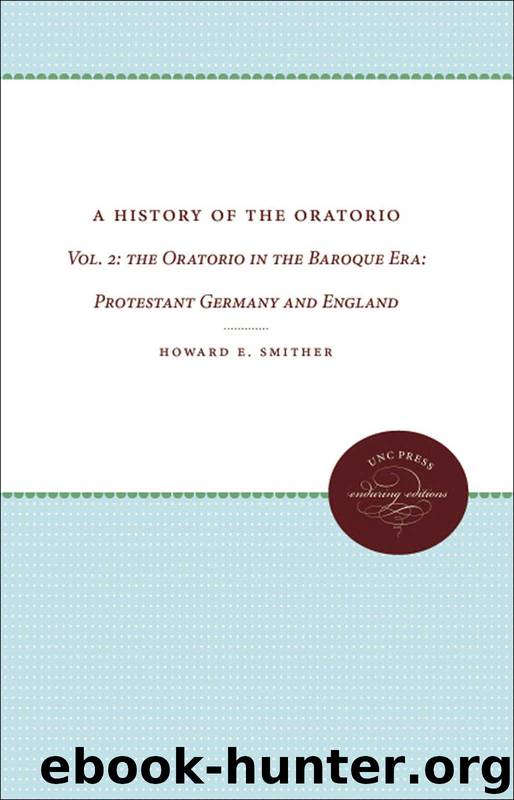A History of the Oratorio: Volume 2 by Smither Howard E

Author:Smither, Howard E.
Language: eng
Format: epub
Publisher: The University of North Carolina Press
Published: 2012-08-31T16:00:00+00:00
An Interlude: 1733–38
The five years that separated Athalia from Saul were primarily opera years for Handel. Despite the successes of his oratorios in 1732–33 and the declining popularity of Italian opera, Handel appears thus far to have had no intention of forsaking the genre to which he had devoted most of his life. In 1732 he had received a letter from the dramatist Aaron Hill, a friend since his early years in England, that appealed to him to compose English operas, to be “resolute enough to deliver us from our Italian bondage; and demonstrate, that English is soft enough for Opera, when compos’d by poets, who know how to distinguish the sweetness of our tongue, from the strength of it, where the last is less necessary.”78 Handel took no apparent heed of Hill’s appeal, so interested was he in composing Italian opera, or perhaps in composing for the excellent Italian singers. Three years later, in 1735, Handel received an oratorio libretto from Charles Jennens-the librettist of Saul, Messiah, and Belshazzar—to whom he replied on 28 July: “I received your very agreeable Letter with the inclosed Oratorio. I am just going to Tunbridge, yet what I could read of it in haste, gave me great deal of Satisfaction. I shall have more leisure time there to read it with all the Attention it deserves. There is no certainty of any Scheme for next Season, but it is probable that some thing or other may be done, of which I shall take the Liberty to give you notice being extreamly obliged to you for the generous Concern you show upon this account.”79 Perhaps it was the libretto of Saul for which Handel thanked Jennens in this letter, but the composer was too busy with an Italian opera, Alcina, to devote much attention to an oratorio.
Alexander’s Feast (1736), composed in the period between Athalia and Saul, is relevant to Handel’s development as an oratorio composer. The libretto is an arrangement by Newburgh Hamilton (the future librettist of Handel’s Samson) of John Dryden’s second Ode to St. Cecilia. Hamilton divided Dryden’s poem into units suitable for recitatives, arias, and choruses, and he added a brief conclusion of his own. In this work Handel continues the flexible approach to structure found in Athalia—an approach including emphasis on the non-da capo aria, the close relationship between solo and choral passages, and the frequent use of accompanied recitatives. Handel did not call the work an oratorio, nor would it be an oratorio according to the usual English meaning of the term in its time: according to Newburgh Hamilton (in 1743), an oratorio is “a musical Drama, whose Subject must be Scriptural, and in which the Solemnity of Church-Musick is agreeably united with the most pleasing Airs of the Stage.”80 Since the word oratorio was relatively new in England, however, it was vague enough in the public’s mind that mistakes were made. For instance, in a letter written in 1739 to her sister, the devoted Handelian Mrs. Pendarves says, “I go to-night to the oratorio—no I mean to Alexander’s Feast-with Mrs.
Download
This site does not store any files on its server. We only index and link to content provided by other sites. Please contact the content providers to delete copyright contents if any and email us, we'll remove relevant links or contents immediately.
Aircraft Design of WWII: A Sketchbook by Lockheed Aircraft Corporation(32188)
The Great Music City by Andrea Baker(31248)
Call Me by Your Name by André Aciman(20347)
The Secret History by Donna Tartt(18803)
The Art of Boudoir Photography: How to Create Stunning Photographs of Women by Christa Meola(18503)
Shoot Sexy by Ryan Armbrust(17637)
Plagued by Fire by Paul Hendrickson(17313)
Portrait Mastery in Black & White: Learn the Signature Style of a Legendary Photographer by Tim Kelly(16932)
Adobe Camera Raw For Digital Photographers Only by Rob Sheppard(16880)
Photographically Speaking: A Deeper Look at Creating Stronger Images (Eva Spring's Library) by David duChemin(16598)
Ready Player One by Cline Ernest(14490)
Pimp by Iceberg Slim(14312)
Bombshells: Glamour Girls of a Lifetime by Sullivan Steve(13949)
The Goal (Off-Campus #4) by Elle Kennedy(13459)
Art Nude Photography Explained: How to Photograph and Understand Great Art Nude Images by Simon Walden(12953)
Kathy Andrews Collection by Kathy Andrews(11706)
The Priory of the Orange Tree by Samantha Shannon(8851)
The remains of the day by Kazuo Ishiguro(8787)
Thirteen Reasons Why by Jay Asher(8765)
